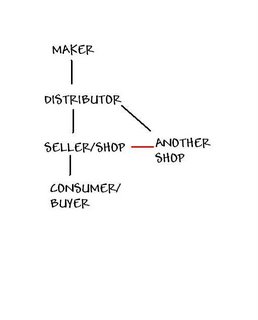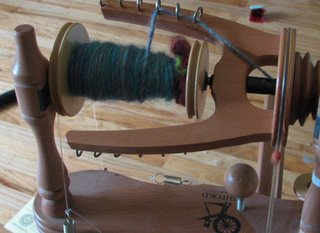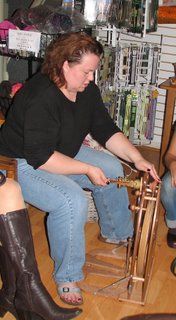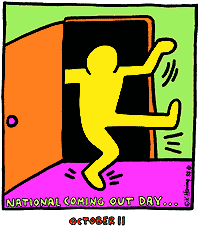Let’s start with a brief overview of antitrust law. (Yeah, I know, I thought it was boring in law school, too. I'll be quick.)
Antitrust law is designed to protect competition and the free market by outlawing agreements and other activities that are bad for competition and the free market. Sounds simple enough. But antitrust is one of those areas that’s very intricate and specialized; it’s also one of those areas where theory doesn’t always mesh with reality.
One of the ways that antitrust law tries to protect the free market is by outlawing price restraints, or practices and agreements that artificially set or preserve prices. The idea is that the free market should determine price. Normally there’s a bit of up and down in pricing: this store sells milk for $5 a gallon, then the store across the street charges $4.75 and makes up the difference by attracting more customers, then the guy across town charges $4.50 but marks up the price of his bread, while the guy who has the only store for fifty miles around can get away with charging $5.50. That’s competition and the market at work. Imagine what would happen if all the supermarkets of the world agreed to sell milk for exactly $5 a gallon, instead of the market determining what people are willing to pay. Once the supermarkets agree to set an artificial price, nobody can get the milk for less than $5, no matter where they are or where they shop. Competition over the price of milk has been eliminated.
Price-fixing is good for the seller: the seller gets a higher price for the goods than the free market necessarily would produce, and the seller knows that the buyer can’t shop around for a better deal elsewhere. Some sellers may not like price-fixing, however; if they are able to offer a product for less, they want to be able to price it lower and recoup the difference in volume.
Price-fixing is primarily bad for the consumer, and you can see why: the consumer is paying more. Depending on circumstances, maybe a lot more.
This kind of agreement among sellers is called horizontal price-fixing, because it involves an agreement to fix prices among people at the same level of the market.

In this diagram, the “horizontal” agreement is between the sellers -- the red line. All the people participating in the agreement – the stores -- are at the same level of the selling chain. Horizontal price-fixing might involve all the makers of a product colluding to agree on price, or all the distributors agreeing on price, and so on. It’s well-established that horizontal price-fixing is bad for competition and therefore illegal under antitrust law.
There’s another kind of price fixing: vertical price-fixing. Vertical price-fixing involves actors who are at different levels of the selling chain colluding to determine price. The Milli Morris example (allegedly! allegedly!) would be analyzed under the law concerning vertical price-fixing: Milli Morris is the maker, and Yolanda's Yarns is the store in my diagram (here, there isn't a distributor; the maker sells directly to shops). Milli and Yolanda are at different levels of the retail food chain, so the alleged price-fixing is vertical.
At first blush, you might think that vertical price-fixing is illegal too, and that it’s all bad for the customer. Not so fast.
Have you ever noticed that no matter where you go to buy a Ralph Lauren Polo shirt (what can I say? my husband is a Skippy with expensive taste), the price is the same everywhere? Exactly the same? You may hit a once-yearly sale, or see remainders from last season marked down a bit, but otherwise Ralph Lauren Polo shirts are always exactly the same price. Coincidence?
You’ve probably seen tons of other products that have a manufacturer’s suggested retail price, or MSRP, on them. Cars, magazines, Tastykakes, whatever. These prices are even printed onto the product or its packaging by the maker. How can that be? Isn’t that vertical price-fixing, an agreement between the maker and the shop to set a price? Here’s where it gets bizarre. It is generally true that vertical price restraints – the maker and the seller agree to charge X amount for the item – are illegal, just like horizontal price restraints are.
But my brief foray into antitrust research suggests that MSRPs are not, by themselves, illegal. The Federal Trade Commission says:
The antitrust laws, however, give a manufacturer latitude to adopt a policy regarding a desired level of resale prices and to deal only with retailers who independently decide to follow that policy. A manufacturer also is permitted to stop dealing with a retailer who breaches the manufacturer’s resale price maintenance policy. That is, the manufacturer can adopt the policy on a "take it or leave it" basis.
So a manufacturer, including a yarn company, can decide it has a "policy" of only selling to shops that abide by the MSRP. It can decide that it won't sell to such shops if they don't consistently charge the MSRP. The legal distinction that's being made, I suppose, is that the maker has the right to decide who it will do business with, and as long as the maker and the seller aren't meeting in a smoke-filled room to come to an express agreement, this is considered lawful. I can't speak to whether this makes sense or not; this concept of permitting MSRPs has been subject to criticism but like it or not, agree with it or not, the FTC says it's okay.
As someone who loves to score yarn cheaply, this grieves me. Everyone feels pinched with their money and everyone would like to get the maximum yarnage for their knitting buck. And the less you pay per skein, the more skeins you can buy with your knitting budget. Required minimum prices, whether they are considered MSRPs or vertical price restraints, tend to raise the cost of yarn by prohibiting discounters. There are other rationales for why we shouldn't permit vertical price restraints: for example, one might argue that by lowering prices, the knitting purchaser gets to try yarns she might otherwise not be able to buy, thereby getting hooked on them and becoming willing to buy them again, even if not discounted. Or that the more knitting people do, and the more they enjoy the process and the finished result (presumably the knitter would enjoy working with nicer yarn more than with lower quality yarn, assuming higher price means better quality), the more they’ll want to continue knitting and the greater the likelihood they’ll turn into hard-core, long-term knitters, thus buying more over the long haul.
But it’s never that simple, is it? While vertical price restraints may seem like a no-brainer, if you look a little deeper, you may see waters that are murkier than you thought.
Imagine a high-end, high quality yarn; I’ll call it Yummy Yarn. Suppose that Yummy Yarn costs $5 a skein wholesale and sells for $10 a skein retail (under a keystone pricing model). Then one day, YarnzRUs.com bursts onto the scene. The dot-com sells Yummy Yarn for $6 per skein, undercutting all the other retailers who sell it for $10 a skein.
How can this be bad, you say? Isn’t cheaper yarn an unqualified good?Well, maybe not if you’re Yummy Yarns. If one internet retailer starts offering Yummy Yarn for only a smidgen above wholesale, a lot of other retailers are going to be unable to sell Yummy Yarn, whether at their shop or on-line. They may have an occasional customer who doesn’t shop on-line, and therefore doesn't have access to the discounted price, but overall, sales of Yummy Yarn everywhere but the dot-com discounter are going to dry up as consumers purchase there. When a great many retailers can’t sell their Yummy Yarn inventory, or their costs are such that they just can’t charge only $6 and still make a profit, they won’t order it anymore. Yummy Yarns is going to lose business. Yummy Yarns might even go out of business. No more Yummy Yarns.
Let’s consider another, similar hypothetical. Selling yarn isn’t the same as selling, say, socks. Everyone in the world knows how to use socks. Everyone in the world knows how socks work and people don’t walk around with serious questions about their socks. But yarn is different. Yarn is used for knitting and crocheting, and learning how to knit and crochet are skills that often require a lot of technical assistance. A large part of my job at my LYS is helping customers with questions and problems about their projects. Easy questions, like what’s a yarn over, and harder questions, like what went wrong with my cable pattern? And selecting the right yarn for the right project can also require assistance from a knowledgeable salesperson: is the gauge right? will it drape? does it have good stitch definition? will the mohair's halo obscure your lace pattern? will it sag? and so on.
Joe’s Sock Emporium doesn’t need to hire salespeople with a whole body of knowledge about how to put on socks. Jane’s Knitting Palace, on the other hand, needs to hire knowledgeable, experienced sales clerks who not only can sell yarn, but can sell the right yarn, and help customers with their technical questions.
And there’s the rub. A good, service-oriented bricks-and-mortar yarn shop needs to pay those knowledgeable and experienced salesclerks. They also need to pay rent, electricity, keep their shop clean and painted and the rugs shampooed, and a myriad of other expenses to keep their physical plant up and running. An internet discounter doesn’t. An internet-only seller can fill orders out of her basement, or out of some cruddy cheap-ass warehouse in a bad part of town, and no one will know the difference. And if you have a question about your project, it's highly unlikely that you could, um, email the shop and expect a prompt and correct answer. (Can you see the email correspondence? “Attached is a JPEG showing my lace scarf. Please tell me what I did wrong.”) Even if the internet seller is tops in service and responsiveness, the costs are not the same as the yarn shop's.
This is what is sometimes known as a “free rider” problem. The reputable bricks and mortar shops provide the free one-on-one assistance, they allow you to sit in their comfy chairs and yak while knitting, they give you a place to feel and touch the yarns, to see what colors it comes in, maybe to handle a swatch. They may give you free patterns or freely give of their experience and advice. And then you go and order the product from an internet discounter, who provides none of these things (and therefore doesn't have to pay the costs associated with them). The internet discounter is free-riding off the services and amenities that the LYS provides. If retailers want to prevent free riders, then, one way to do it is to set a minimum price for all retailers to follow.
Finally, there’s the prestige factor. Those of you who are, ahem, my contemporaries may remember when expensive perfumes like Giorgio and Obsession were only available at high-end department stores. The fragrances were distinctive and if you knew someone who reeked smelled of Obsession, you knew they’d paid a pretty penny for it at Bloomingdale's or Nordstrom's. Nowadays, you can find the same perfumes at CVS, or at Marshall’s or other places, being discounted. The snob appeal is gone. The products, though cheaper, are, in a weird way, less desirable.
Some people -- even yarn manufacturers -- believe it’s important to maintain this exclusivity, this high price, the prestige as part of their market niche. They don’t want to see their yarns sold at a deep discount on Ebay, or available at a big box craft store; they want to maintain a high-end cachet. I'm not saying whether this is wrong or right: it just is. And some yarn manufacturers don't give a rat's ass about the prestige, but they know that people who buy their yarn will benefit from the skills and services that the full-service yarn shop can offer. If Patsy Purl makes a project out of an unsuitable yarn and hates the finished garment, she may blame it on the yarn manufacturer. ("I'm never making a sweater out of Yummy Yarn again!") If, on the other hand, a knowledgeable salesperson deters her from an unsuitable choice and helps her pick a better one, Patsy Purl may be hooked on Yummy Yarn for life.
I point all this out so you can appreciate the complexity of some of these issues. You don’t want your favorite yarn shop to go out of business or stop carrying your favorite yarns, and you don’t want your favorite yarn manufacturer to stop making yarn either. Cheap yarn is nice, but it’s also good to take a broader view. Internet sellers who don't have a bricks-and-mortar presence don't always think about the broader effect they are having on the market.
Now regardless of all of these rationales, the fact remains that vertical price restraints, actual agreements between the distributor, say, and the LYS about price, are illegal. There are other ways that makers address some of these problems:
- Adopt a MSRP policy as described above.
- Require that sellers have a traditional physical yarn shop -- not just an internet site -- as a prerequisite to sales. That way the maker knows that all sellers are all on a level playing field when it comes to overhead, free riders, providing technical assistance and such.
- Some yarn companies have geographic limitations or territories, and they only permit one authorized retailer within a certain number of miles.
- Maintain the traditional distinction between sales to yarn shops and sales to large national craft chains, selling to the former and not the latter. (Large chains buy in quantity, they can use items as loss leaders in a way that small shops can’t, they run discounts and offer coupons, all leading to the undercutting of price. Craft stores tend not to have salespeople with the same level of expertise in knitting. There’s also an exclusivity element: if you go into a yarn shop, you expect to see things that the craft stores don’t carry, and seeing the same yarns available at both places devalues those yarns, at least in some folks' eyes.)
- Have a minimum advertised price: the seller agrees to advertise a price no less than a specific minimum, so that the impact on other sellers is reduced.
- Other secret arrangements, that may or may not be illegal, like selling at a lower wholesale price to sellers who abide by the MSRP policy, or rewarding sellers who stick to the MSRP by giving them "bonuses" of cash or merchandise or other freebies, or taking your own sweet time to fill the orders of the discounters while promptly shipping product to the MSRP-honoring sellers.
I don't know what the ultimate answer is. Maybe there isn't one. But I urge you to think about some of the issues I've raised and at least appreciate that things aren't always as cut-and-dried as they first seem.
Okay, go on, have at it. Just remember to play nice.


















































